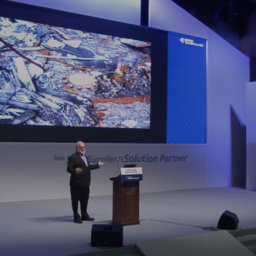Throughout the history, the steel industry has been consistently pursuing technical innovations to develop materials demanded by each era. The mechanical achievements from previous years are reflected in all of our merchandise in use. Today, we would like to review how the global steel technology has been formed around the innovative technology and products within the steel industry.
[Innovative Steel Technology] Amplification of Green and Economical Technology through Endless Research & Development
FINEX Process FINEX is an innovative steelmaking process that has altered the conventional paradigm of ‘producing molten metal in a blast furnace’. It is designed to produce molten metal using cheap, powder-type iron ore and bituminous coal and as a result, saves much in investment and fuel processing costs while reducing the amount of polluting substances produced. Commercialized for the world’s first by POSCO, FINEX plant with the annual production capacity of 1.5 million tons, has been running successfully since its launch in 2007. Moreover, 2 million tons of additional facilities has been on-stream in recent years.
FINEX is an innovative steelmaking process that has altered the conventional paradigm of ‘producing molten metal in a blast furnace’. It is designed to produce molten metal using cheap, powder-type iron ore and bituminous coal and as a result, saves much in investment and fuel processing costs while reducing the amount of polluting substances produced. Commercialized for the world’s first by POSCO, FINEX plant with the annual production capacity of 1.5 million tons, has been running successfully since its launch in 2007. Moreover, 2 million tons of additional facilities has been on-stream in recent years.
Hydrogen-based Steelmaking Process
‘Hydrogen-based steelmaking process’, using Hydrogen (H) instead of coal as a reducing agent, is also at the research stage. Generally, iron ore exists in a state which iron and oxygen are in combination (Fe₂O₃, Fe₃O₄). If coal is used as the reducing agent for separating oxygen, carbon dioxide emission is inevitable in the process. However, if hydrogen replaces carbon as the reducing agent, the reaction with oxygen will result in water and thereby process steel without any CO₂ emission. However, technical and financial issues on securing a large amount of hydrogen follow in accordance. As a possible solution, nuclear energy is currently being considered.
Thin Slab Casting
The steel industry is heading to the direction of environmental-friendly business by revamping the steel process as a direct and consecutive procedure. The new eco-friendly steel process that remarkably reduces energy consumption, is being developed. The most representative case is the ‘thin slab casting’ which manufacturers ‘slab’, the intermediary material, in the thinnest possible form in order to minimize the additional heating temperature.
Compact Endless cast-rolling Mill (CEM) Process
Lately, a new method for creating hot-rolled steel sheet that does not reheat the thin slab has been under development. This innovative technology developed by POSCO is called CEM (Compact Endless cast-rolling Mill) process. The CEM process consecutively produces thin slabs and immediately connects them with the hot-rolling process as a means to create hot-rolled steel products. Through this process, energy consumption of the previous casting process will be saved up to 50%.
[Innovative Steel Products] Leading the Automobile and Energy Industry with High-Quality Materials
Automobile
The automobile industry, which is large in steel consumption, is reaching the pinnacle of eco-friendly vehicle development. Engine efficiency should be enhanced by lightening the vehicle weight in order to improve fuel efficiency. That is, automotive flat products, which occupy most of the vehicle weight, should be lightened. The best method for this issue of the current state is the Hot Press Forming (HPF).
However, there has been a development of new steel material that has sufficient strength and processability without being processed. The best-known example is PosM Steel which was developed by POSCO in 2010. Compared to regular automotive flat products, the PosM Steel sheet, a mixture of iron, manganese, and aluminum, is 3-4 times stronger and about 30% lighter. As a matter of fact, POSCO reduced 130kg from an auto body of ‘EOLAB’ concept car which was a recent cooperation with Renault. The weight reduction enabled the car to run at 100km per liter of fuel. In response to the commercialization of electric automobiles, the innovative electrical steel of high electrical efficiency is under development while super metal with better strength is also in the research process.
Energy
Innovative steel products are being expanded in the energy sector as well. Due to the generalization of deep-sea oil field development, a competition for exploitation of unconventional resource such as shale gas is now at its heights. Accordingly, FPSO (Floating Production Storage and Offloading) for energy development, is expanding in its demand. Used in the offshore plant, the steel material for energy is known for its high quality and safety standards because it must endure the extreme condition of deep sea and the Polar Regions.
In order to meet the strict standards, an alloy steel that holds strength and impact toughness even in an extremely low temperature is under development. Notably, the newly invented high manganese steel is an advanced product of 25% increase in manganese content. The increment in content improved the steel’s low thermal expansion, machinability, and processability. Thus, the steel can dramatically increase the storage capacity of an LNG tank.
Manufactured at a lower price through the environmentally friendly production process, the innovative steel products will solidify its status as key materials within the steel industry. The advancement in the automobile, shipbuilding and energy industry would have been impossible if the innovation of the steel material did not occur. The joint-growth paradigm which is brought by the cooperation between the demanded industry and the steel industry will continue to go on even in the future.




